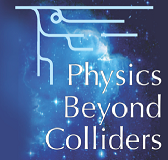Speaker
Description
The lifetime of the short-lived ($\tau_{th}$ about $3\times10^{-15}$ s in the ground state) $\pi^+K^-$, $K^+\pi^-$, ($\pi^+\pi^-$ ) atoms($A_{\pi^+K^-}$, $A_{K^+\pi^-}$ and $A_{2\pi}$ ) is given within 1% (0.6%) precision by the S-wave $\pi K$ ($\pi\pi$) scattering length combination $|a_{1/2}-a_{3/2}|$ ($|a_0-a_2|$), where 1/2, 3/2 (0, 2) are the isospin values. Furthermore, the study of long-lived $A_{2\pi}$ states (states with non-zero orbital momentum, $\tau\geq1\times10^{-11}$ s) allows to measure the Lamb shift depending on another $\pi\pi$ scattering length combination $2a_0+a_2$. Therefore, the investigation of dimesonic atoms is the tool to measure model-independently $\pi K$ and $\pi\pi$ scattering lengths, which have been calculated precisely in the framework of LQCD (Lattice QCD) and ChPT (Chiral Perturbation Theory). Up to now, dimesonic atoms have been investigated only in the experiment DIRAC, using the CERN PS 24 GeV/c proton beam.
The S-wave ππ scattering lengths described in QCD exploiting $SU(2)_L\times SU(2)_R$ symmetry breaking and confirmed experimentally with precision of about 4%. But these measurements - independently from their accuracy - cannot check the QCD predictions based on the chiral $SU(3)_L\times SU(3)_R$ symmetry breaking for strange sector. This check can be done by investigating the S-wave $\pi K$ scattering lengths, where the s quark is involved.
LQCD and ChPT give $|a_{1/2}-a_{3/2}|$ with a precision of about 5% and 10%, respectively. The best direct measurement of this combination has an average precision of 35% (DIRAC experiment, to be published). It is obvious that for the time being LQCD and ChPT predictions, based on chiral $SU(3)_L\times SU(3)_R$ symmetry breaking, have not be checked experimentally with enough accuracy. A recent study has shown that the $\pi^+\pi^-$ $\pi^+K^-$, and$ K^+\pi^-$ atom production per time will be $12\pm2$, $53\pm11$ and $24\pm5$ times higher than in the previous DIRAC experiment, if the incident proton momentum raise from 24 to 450 GeV/c $(\theta_{lab}=4^\circ)$ and take in to account the SPS beam duty factor. This significant increase in $A_{\pi^+K^-}$ and $A_{K^+\pi^-}$ production makes it possible to measure $|a_{1/2}-a_{3/2}|$ at the 5% precision level with DIRAC in a comparable running time. For the first time, our thinking about chiral $SU(3)_L\times SU(3)_R$ symmetry breaking in QCD could be checked. The setup upgrading and geometry modification will enable a significant precision improvement.
The $\pi\pi$ scattering lengths $a_0$, $a_2$ and their difference have been calculated in ChPT with precision of 2.3% and 1.5%, respectively. The accuracy of these parameters can be improved. In some recent works, $\pi\pi$ scattering lengths were calculated using LQCD: with precision about 5% and less than 1.5%. Currently, only $|a_0-a_2|$ has been measured in the NA48 and DIRAC experiments with a precision of about 4%, confirming the theoretical predictions. The scattering length $a_2$ has been determined by NA48 with a precision of 22% . The strong increase of the $A_{2\pi}$ yield allows to improve the $|a_0-a_2|$ precision and to begin the study of the long-lived atom $A_{2\pi}$, which has been observed by DIRAC in 2015.
For all investigation of dimesonic atoms, the DIRAC experiment uses very thin targets without disturbing the proton beam and, hence, can be installed upstream of other experiments in the same beam.
